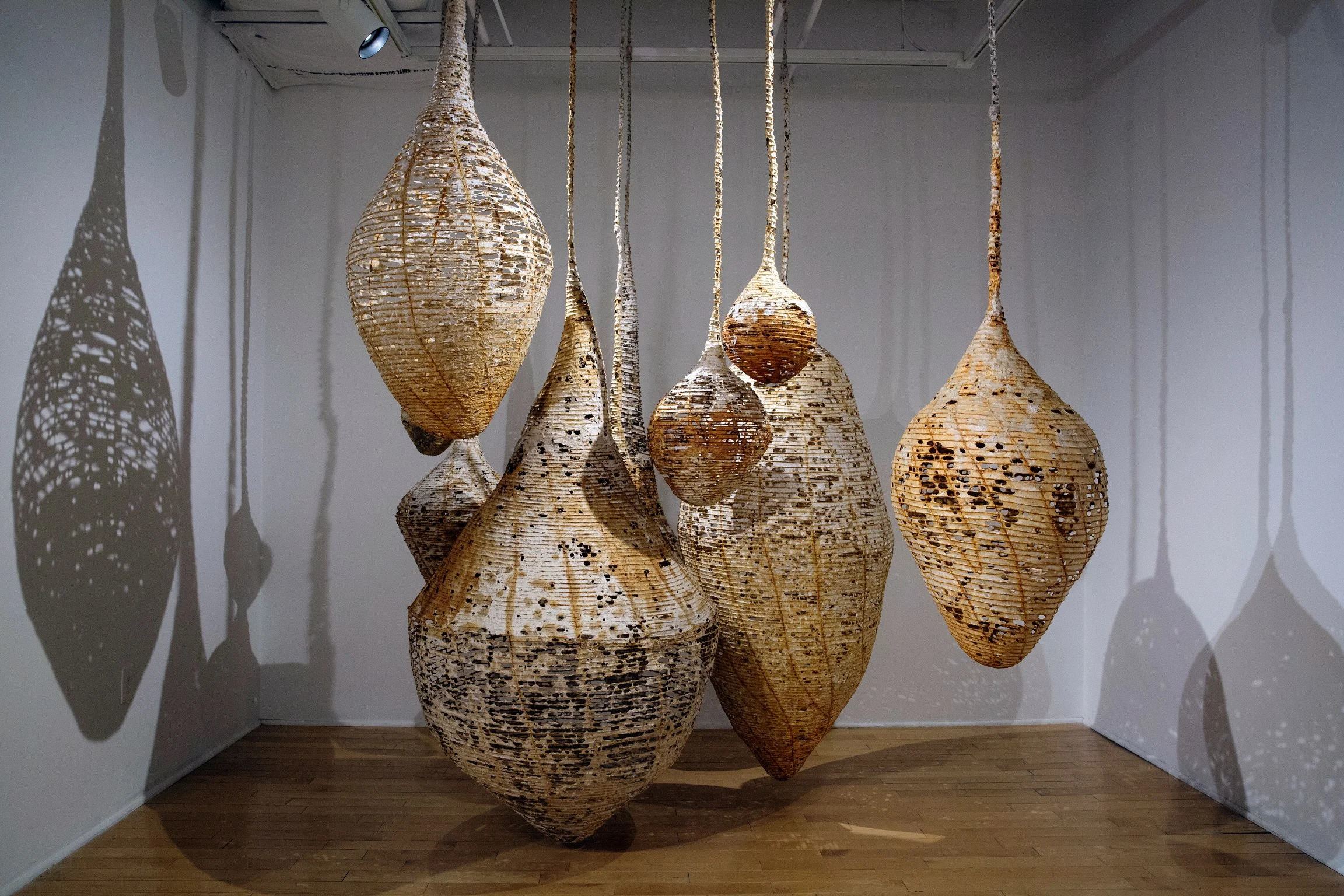Interview with Hanna Vogel
Hanna Vogel
Was, Might Be, 2017
Steel wire, abaca and cotton paper, pigment, rust, sealant
183 x 83 x 94 in.
Hanna Vogel is an artist, writer, and educator living in Philadelphia, PA. Born and raised in rural northern California, she received a BFA from the California College of the Arts and an MFA from the University of Massachusetts Dartmouth. In this interview, Hanna speaks to Justin Archer about the influences behind her installation based works, development as an artist, and the impact of writing.
JA: Can you tell us a little about yourself and what led you to becoming an artist?
HV: I grew up in a small, rural town in Northern California. I read tons of fiction as a kid and for most of my childhood I wanted to be a writer when I grew up. I’ve always loved the way that fiction creates a psychologically immersive world that can feel as real as the physical world. In high school I took a ceramics class as an elective and fell in love with the process and seemingly endless potential of turning mud into functional or sculptural objects, but it still didn’t occur to me to make art as anything more than a hobby. In college I started out studying creative writing at Reed College but eventually realized that I was spending all my time in the ceramics studio, so I ended up transferring to the California College of the Arts where I got my BFA in ceramics. A few years after that I moved to Massachusetts for my MFA in ceramics and fibers and since graduation have lived and worked in Philadelphia, PA.
JA: How do you feel that the place you grew up has influenced or contributed to the work that you are producing?
HV: I got to spend a lot of time in old-growth redwood forests during my childhood, and their unique spatial dynamics have definitely influenced the way I think about spaces and structures. The trees are gigantic—they’re too tall to see to their tops and so wide at the base that they block any view of a distant horizon. This has the effect of flipping the horizon line to vertical as you glimpse small patches of sky between the receding treetops. The space feels expansive but protected, a bit like being both inside and outdoors at the same time. The trees become a sort of living architecture, which gives a new understanding to what it means to be a living object (whether immobile tree or moving human) within a particular space. I see parallels between the ways those giant trees create structure and define space with their living mass and the ways in which we use our bodies to interpret and relationally define the spaces we inhabit.
JA: I’m interested in learning how you made the transition from more traditional ceramics discipline to the installation based works. Many of the pieces you have created recently still resemble the form of a vessel but with a much broader use of materials and process.
HV: I started thinking more about the spatial relationships between sculpture and the viewer’s body. Over the past five years or so I’ve gotten increasingly interested in how we use our senses to perceive and understand our surroundings but also only understand ourselves (as physical objects) in terms of our surroundings. With that in mind, my work has gotten larger and I’ve started incorporating multiples in various installation formats to highlight the spatial relationships between the parts of the installation and between the art objects and the viewer’s body.
In practical terms, ceramic is pretty inconvenient on such a large scale, since it’s so heavy and fragile. In some of my recent installation work I’ve used ceramic specifically because of its fragility and structural improbability on an architectural scale. In the majority of my recent work, however, I’ve moved into various fibers-based processes. I use a basketry technique to weave steel wire into sculptural forms, then pour paper pulp over them. The pulp shrinks as it dries, forming a stretched, porous skin over the wire. The iron in the wire rusts with the moisture in the paper pulp and the rust stains the paper. I’m interested in the conceptual potential of these materials and process—vessel-like forms that evoke growth and new life contrasting with materials that allude to organic decay.
JA: What does your process look like to create one of your installations? How does it grow and develop from the initial inception to the final image?
HV: I start a new project with a basic idea of the spatial relationship I want it to have to the viewer’s body and the emotional impact I want it to have. I’ve learned not to start with an overly specific plan for the final product, instead letting grow more organically. My studio is full of small test pieces of various materials and processes, and I use them as a sort of reference library when deciding what form(s) a new installation will take. Once I figure that out, the next phase is weeks or months of making the installation components. If there’s space available, I like to start assembling the parts while I’m still making them so that I can get a sense of what it feels like in actual life-sized space.
Once I’ve made all the parts, I install as many as will fit in my studio before taking them to the gallery for the full-sized installation. This allows me to work out any technical issues I haven’t foreseen, and it also helps me to more fully understand the conceptual aspects of the work. Most of my installations are site-responsive, so the specific layout changes a bit depending on the space, but the basic scale and spatial relationships between the work and the human body stay the same, as does the conceptual content.
JA: Who do you feel has impacted or influenced your studio practice most significantly?
HV: Some of my favorite installation artists are Chiharu Shiota, Cornelia Parker, and Yasuaki Onishi. They all work on a pretty large scale and, in different ways, use mundane materials in non-traditional and spatially interesting ways. Yasuaki Onishi really transforms his materials (he often uses pigmented hot glue and big sheets of plastic) turning them ethereal landscapes that seem almost too beautiful to be solid objects. Chiharu Shiota uses monochromatic string to define architectural spaces that are usually left empty and therefore often go ignored, tying them (physically and psychologically) to objects that reference various aspects of human experience. Cornelia Parker repurposes objects or fragments of objects with specific material histories, installing them in new and abstracted formats that contradict or contrast with their origins.
My work is also influenced by my favorite fiction, which is often magical realism. I love those moments when the seemingly normal world of the story suddenly ignores the law physics, instead manifesting a more poetic, if physically impossible, reality. I find some of those metaphors so beautiful in they way they describe what feels like a more profound truth. One of my favorites, from Shalimar the Clown by Salman Rushdie, is when Shalimar’s dad is teaching him walk on the tight-rope. He says,
“Don’t think of the rope as a safety line through space. Think of it as a line of gathered air. Or think of the air as something preparing to become rope. The rope and the air are the same. When you know this you will be ready to fly. The rope will melt away and you will step out onto the air knowing that it will bear your weight and take you wherever you may want to go.”
Later, Shalimar is escaping from prison, running along the top of the prison wall. Remembering his father’s advice, he runs off the end of the wall, up into the sky, and escapes.
JA: You write a lot in your practice and have even been published for your thoughts on art and its relationship to space the human body. Have you been working on any new writing projects?
HV: I find that writing, both about my own work and that of other artists, helps me to better understand what my work is about and why. After I finish an installation I sit down a write a page or two about it. It’s at this point that I really figure out what it’s specifically about, beyond the general idea that I started with.
About a year and half ago my writing collaborator and I had a paper about embodiment in installation art published in The Yearbook of Moving Image Studies in Germany. We’ve both been pretty busy since then but are in the beginning stages of working on a new paper about how Doris Salcedo and Chiharu Shiota use excess (in both materiality and process) as a method of indirectly addressing content that feels too weighty to deal with otherwise.
JA: What would be your dream project if there were no limitations?
HV: Oh, I love this question! Ideally, I’d have access to a huge cathedral-like building where I could hang things from the ceiling and walls. I’d love to create a really immersive installation where most of the objects don’t touch the floor but different parts get really close. Maybe there would be some ladder-like things that led to various platforms so that viewers could climb up into the installation and see different parts that aren’t visible from the floor. I love the idea of finding hidden spaces and feeling like you’re floating in space. I’m sure it would involve a ton a material experimentation, but I’d probably use some combination of handmade paper, woven wire, stiffened fabric, string, and metal.


